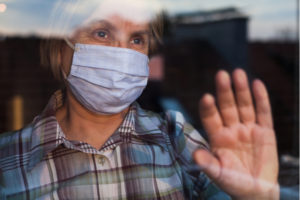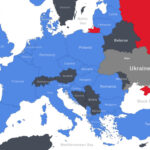
By Cryptographer @ Shutterstock.com
Pandemic Report No. 10
Every individual victim of Covid-19 is a tragedy. I have a brother who has been battling for his life after infection, so I am not downplaying these individual personal tragedies in the least.
But in a collective sense, the population that has suffered the most from Covid-19 are the elderly residents of our nursing homes and rehabilitation centers. Overwhelmingly they have immune-suppressing underlying medical conditions that have made them particularly vulnerable to this pandemic.
Spending one’s final years in an institution is sad enough, but having to undergo that with the fear of an unseen killer and enforced separation from loved ones is horrendous, and almost impossible to conceive. But that has been their fate, even when financial resources have allowed them to be placed in the “best” nursing homes.
In the United States, somewhere between 40% and 50% of Covid-19 deaths have probably occurred in nursing homes—I say “probably” because all statistics relating to the pandemic are approximations at best, due to different standards in measuring and reporting them. In some European countries, the percentage of Covid-19 deaths occurring in nursing homes has been even higher.
One reason there have been fewer Covid-19 deaths in “developing” countries—so far—is because nursing homes are not as common in Third World countries. There, the elderly most often die in the traditional way—at home among family. Nursing homes are a relatively recent creation of First World nations.
This is not necessarily a matter of insensitivity. Families in advanced economies are continually becoming smaller, thanks to birth control and societal changes. Indeed, with our present economy, most households have either one wage-earning adult, or two where both incomes are necessary for the family. That doesn’t leave anyone to take care of an elderly parent who needs constant supervision, and that leaves institutions as the only alternative.
Of course there are examples, even in today’s society, of families taking care of their own elderly. I’ve known some of them, and they should be honored. Financial circumstances allow them to do this, but it’s usually a burden. Nevertheless they step to the plate, and I call them “unrecognized saints.”
One is the wife who took care of her mother, installing special equipment in the home, and then did the same for her mother-in-law. Of course the husband was also involved in these actions, but she was the one tasked with most of the personal care. Women usually are.
Another is a couple that spent $50,000 to build an addition to their house so her mother could join the family rather than be institutionalized. As is usually the case, both the grandmother and the grandchildren love this arrangement.
My third example involves a couple, married for more than 50 years, where he has been taking care of his semi-invalid wife at home since she had a series of strokes. Now he has even more challenging physical problems, but their two daughters (and one daughter’s partner) have moved in for weeks to help their parents, at great inconvenience. I know they will continue to try and keep their parents at home if at all feasible.
This is an instance where remote work makes this possible, an option not available to many people. And, as I’ve noted, the great majority of families do not have the financial ability to care for their elderly parents at home. That leaves us with the nursing homes.
Politicians and the Nursing Homes
Sad as this situation is, it becomes worse because of politicians and their dictates.
The most obvious example involves Gov. Andrew Cuomo of New York, the state hit hardest by the coronavirus. He has received praise, justifiably so in my opinion, for his demeanor in his daily pandemic briefings. He comes across as authoritative, calm, and even with self-effacing bits of humor. Would that all of our grandstanding politicians were capable of that.
Behind that public façade, however, are egregious and avoidable political mistakes that have been disastrous for residents of the nursing homes in New York State.
On March 25 he issued a directive requiring nursing homes in the state to admit coronavirus patients. You don’t have to be a chemistry student to realize that this would lead to an explosion of deaths in the very institutions that were already most vulnerable to the virus.
New York’s health department refuses to release a tally of how many coronavirus patients were sent to nursing homes under this directive. But the Associated Press has done its own painstaking count, and comes up with more than 4,500 such virus patient transfers. To no surprise, at least 5,800 Covid-19 deaths—probably more—have occurred in those nursing homes.
All this was predictable. The 460-bed Gurwin Jewish nursing home on Long Island, for example, was well prepared at the start of the pandemic. But after the state directive required them to admit 58 Covid-19 patients, 47 Gurwin residents died of confirmed or suspected Covid-19.
The Society for Post-Acute and Long-Term Care Medicine, known as AMDA, warned from the beginning that Cuomo’s order presented a “clear and present danger” to nursing home residents.
And another sign of coverup: The New York State Department of Health provides a listing of 2020 press releases with “Information on Novel Coronavirus,” touting the governor’s micromanagement of the pandemic. But that March 25 directive to nursing homes is not listed.
The governor has tried to wiggle his way out of this embarrassment by blaming the federal government under President Trump—of course. But the top federal official overseeing nursing homes—Seema Verma, head of the Centers for Medicare and Medicaid Services—adamantly insists Cuomo’s executive order did not follow her agency’s guidelines. “The federal guidelines are absolutely clear about this.”
After the disastrous results of his directive became obvious, and he belatedly reversed the directive on May 10, Cuomo still tried to evade responsibility by claiming that the nursing homes could have declined admission: “Any nursing home could just say, ‘I can’t handle a Covid person in my facility.’” But the March 25 directive did not mention such a right to refuse: “No resident shall be denied re-admission or admission to [nursing homes] solely based on confirmed or suspected diagnosis of Covid-19.” And as late as April 23 he had been singing a different tune: “They get paid to provide a service. They get regulated by the state government. There are certain rules and regulations that they must follow and we put in additional rules and regulations on nursing homes in the midst of this crisis.”
Michael Goodwin, a Pulitzer Prize-winning columnist at the New York Post, calls this a “massacre of a helpless population.” And he reports: “Nursing home executives, meanwhile, complain privately that Cuomo should have known his mandate would be a killer, but they were never consulted and got no notice before being swamped with infected patients. As one owner put it, longtime residents began ‘dropping like flies’ soon afterward. These same executives will not go public with their complaints because they fear Cuomo will punish them with fines and take their licenses.”
We were warned by the nation’s first large coronavirus outbreak—the one at that nursing home in Kirkland, Washington. And Cuomo isn’t the only guilty governor. Gov. Phil Murphy of New Jersey issued an almost identical order six days after Cuomo, and Gov. Gretchen Whitmer of Michigan has also issued such a directive. (Full disclosure: All three are liberal Democrats who claim to speak for the disadvantaged—but who is more helpless than these nursing home patients?)
Cuomo, however, basking in the approval ratings for his daily briefings, may be dreaming of a higher office. But the record proves he is not worthy of even his present position.
My Previous Articles on the Coronavirus Pandemic
- How Big of a Threat Is the Coronavirus? (March 26)
- How Bad Has the Pandemic Been? How Bad Will It Be? (April 6)
- An Economic Shutdown Based On…What? (April 15)
- Is Sweden’s Problem Coronavirus or Immigration? (April 21)
- Let the Lockdown End, County by County (April 27)
- Reopen the Economy and Protect the Most Vulnerable: We Can Do Both (May 4)
- The Best Defense Against Covid-19 is a Strong Immune System (May 15)
- Why Covid-19 is So Different from Previous Pandemics (May 26)
- Like Humpty Dumpty, the Lockdown Hoax Comes Tumbling Down (June 6)
And see all my articles in this pandemic series.




